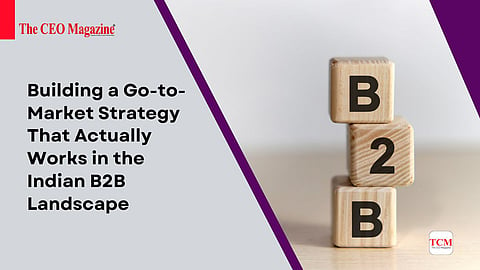
- News
- Women
- Magazine
- IndustryIndustry
- InsightsInsights
- Success Stories
- PublishPublish
- ContactContact
- Media KitMedia Kit

Let me ask you something:
Have you ever launched a product that looked perfect on paper, but then… it just didn’t move in the market?
If that’s ever happened to you — you're not alone.
In the Indian B2B landscape, building a go-to-market strategy that actually works is more science than luck, and more local intelligence than global templates.
In my experience working with Indian founders, investors, and CXOs, one thing is clear — you can't simply copy-paste a Silicon Valley playbook into Mumbai, Bengaluru, or Gurgaon.
It just won’t work.
So, let me walk you through what does work — with examples, frameworks, and hard-won lessons tailored for the Indian B2B ecosystem.
Before we dive into strategy, let's understand the battlefield.
Unlike the West, India’s B2B buying decisions are highly relationship-driven.
Purchase cycles are longer. Budgets are tighter. Trust matters more than branding.
“In India, trust precedes transaction. Relationships precede revenue.” — a common saying among top B2B sales leaders.
You’re dealing with:
Diverse industries (from manufacturing to IT to logistics)
Multiple decision-makers (and layers of approvals)
Localized buying behaviors (tier-2 cities vs metros)
In short? Your go-to-market (GTM) plan must be deeply contextual to India.
ICP = Ideal Customer Profile.
If you try to sell to everyone, you’ll end up selling to no one.
Target by industry vertical, not just company size.
Eg. A SaaS CRM for real estate agencies in South India performs better than a generic CRM.
Map roles, not just companies.
Who signs the cheque? Who influences the decision? Who uses the product?
Pro tip: Create a 3-layer ICP — industry → company type → decision-maker title.
Here’s the secret:
Your customer doesn’t care about your product.
They care about what your product can do for them — fast.
In the Indian context, that means:
Speak the language of ROI: "Save 25% on procurement costs"
Add social proof: “Trusted by 150+ Indian SMEs and 3 Fortune 500 clients”
Address local concerns: “Complies with Indian GST & data regulations”
If I had 10 seconds in an elevator with my buyer, could I make them curious enough to ask for a demo?
Your go-to-market strategy in India must align with your product maturity, price point, and industry.
Model
Best For
Key Considerations
Direct Sales
Mid-to-enterprise B2B
Needs strong relationship management
Channel Partners
Tier-2/3 city outreach
Choose partners with local networks
Freemium / Self-Serve
Tech-first SMEs
Works if product is easy to adopt
Inside Sales / SDR Teams
Scalable SaaS
Needs tight lead-gen + CRM systems
In my experience?
Many startups waste months on self-serve funnels before realizing that direct sales win faster in India.
Indian B2B buyers want education before persuasion.
They look for thought leadership, case studies, and even offline trust signals.
Whitepapers or use cases with real ROI numbers
Founder-led LinkedIn content (People buy from people!)
Participation in local B2B events and expos
Regional webinars in Hindi, Tamil, or Telugu depending on your geography
Imagine this:
A founder of a B2B fintech startup regularly posts short videos on LinkedIn breaking down RBI regulations. That builds trust far before a sales call happens.
A common trap: Sales teams chasing cold leads, marketing teams generating vanity metrics.
Let’s fix that.
Lead qualification criteria (What is a ‘sales-ready lead’?)
Demo-to-close process (Use tools like HubSpot or LeadSquared)
Follow-up cadences (Indian buyers need persistence)
Create a GTM playbook that includes:
Email templates
Objection handling FAQs
Post-demo follow-up workflows
Local success stories and references
“Sales doesn’t start with a pitch. It starts with a playbook.” — My mentor from a Mumbai-based SaaS unicorn
Too many B2B startups focus only on Delhi, Mumbai, Bengaluru. But India is evolving fast.
Indore, Surat, and Nagpur are new B2B growth hubs.
Digitization of SMEs is exploding thanks to UPI, ONDC, and government reforms.
Many firms here are hungry for tech, but require hand-holding and trust-building.
Consider hiring local sales reps or partners in non-metro cities to accelerate this channel.
You can't fix what you don’t track.
But in Indian B2B, don’t just chase lead volumes. Measure conversion-quality metrics.
Lead-to-demo rate
Demo-to-close rate
Sales cycle length by region
Churn rate after 3–6 months
Set up dashboards early. Use tools like Zoho CRM, LeadSquared, or Salesforce depending on your scale.
India-born unicorn Freshworks cracked the B2B GTM code by:
Starting with inside sales for global SMBs
Positioning clearly as "affordable alternative to complex CRMs"
Investing in founder-led content and conferences
Scaling with India-based sales teams serving global clients
They blended Indian cost advantage with Western-style GTM playbooks — adapted to fit Indian nuances.
Let me leave you with this:
A great go-to-market strategy in the Indian B2B world isn’t a slide deck you present once.
It’s a living, breathing system you iterate, refine, and evolve constantly.
You’ll tweak messaging. Add new verticals. Drop channels that don’t convert. That’s okay.
But as long as you keep listening to your customer, respecting the Indian buyer mindset, and staying agile —
Your startup can scale faster, smarter, and more sustainably.
Need help refining your GTM for the Indian market?
Share this with your team and start crafting your 90-day GTM roadmap today.
Follow us on Google News
